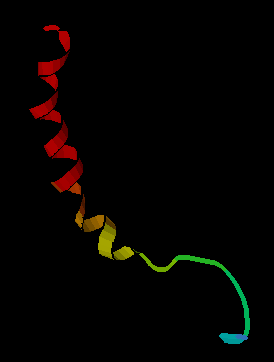Neuropeptidergic means "related to neuropeptides".
A neuropeptidergic agent (or drug) is a chemical which functions to directly modulate the neuropeptide systems in the body or brain. An example is opioidergics.
Neuropeptidergic means "related to neuropeptides".
A neuropeptidergic agent (or drug) is a chemical which functions to directly modulate the neuropeptide systems in the body or brain. An example is opioidergics.

Peptides are short chains of amino acids linked by peptide bonds. A polypeptide is a longer, continuous, unbranched peptide chain. Polypeptides that have a molecular mass of 10,000 Da or more are called proteins. Chains of fewer than twenty amino acids are called oligopeptides, and include dipeptides, tripeptides, and tetrapeptides.

Neuropeptides are chemical messengers made up of small chains of amino acids that are synthesized and released by neurons. Neuropeptides typically bind to G protein-coupled receptors (GPCRs) to modulate neural activity and other tissues like the gut, muscles, and heart.

Neuropeptide Y (NPY) is a 36 amino-acid neuropeptide that is involved in various physiological and homeostatic processes in both the central and peripheral nervous systems. It is secreted alongside other neurotransmitters such as GABA and glutamate.

FMRFamide (H-Phe-Met-Arg-Phe-NH2) is a neuropeptide from a broad family of FMRFamide-related peptides (FaRPs) all sharing an -RFamide sequence at their C-terminus. First identified in Hard clam, it is thought to play an important role in cardiac activity regulation. Several FMRFamide related peptides are known, regulating various cellular functions and possessing pharmacological actions, such as anti-opiate effects. In Mercenaria mercenaria, FMRFamide has been isolated and demonstrated to increase both the force and frequency of the heartbeat through a biochemical pathway that is thought to involve the increase of cytoplasmic cAMP in the ventricular region.
In molecular biology and physiology, something is GABAergic or GABAnergic if it pertains to or affects the neurotransmitter gamma-aminobutyric acid (GABA). For example, a synapse is GABAergic if it uses GABA as its neurotransmitter, and a GABAergic neuron produces GABA. A substance is GABAergic if it produces its effects via interactions with the GABA system, such as by stimulating or blocking neurotransmission.
Glutamatergic means "related to glutamate". A glutamatergic agent is a chemical that directly modulates the excitatory amino acid (glutamate/aspartate) system in the body or brain. Examples include excitatory amino acid receptor agonists, excitatory amino acid receptor antagonists, and excitatory amino acid reuptake inhibitors.
Neuropeptide Y receptors are a family of receptors belonging to class A G-protein coupled receptors and they are activated by the closely related peptide hormones neuropeptide Y, peptide YY and pancreatic polypeptide. These receptors are involved in the control of a diverse set of behavioral processes including appetite, circadian rhythm, and anxiety.

The neuropeptide S receptor (NPSR) is a member of the G-protein coupled receptor superfamily of integral membrane proteins which binds neuropeptide S (NPS). It was formerly an orphan receptor, GPR154, until the discovery of neuropeptide S as the endogenous ligand. Increased expression of this gene in ciliated cells of the respiratory epithelium and in bronchial smooth muscle cells is associated with asthma. This gene is a member of the G protein-coupled receptor 1 family and encodes a plasma membrane protein. Mutations in this gene have also been associated with this disease.
The neuropeptide B/W receptors are members of the G-protein coupled receptor superfamily of integral membrane proteins which bind the neuropeptides B and W. These receptors are predominantly expressed in the CNS and have a number of functions including regulation of the secretion of cortisol.
The neuropeptide FF receptors are members of the G-protein coupled receptor superfamily of integral membrane proteins which bind the pain modulatory neuropeptides AF and FF. The Neuropeptide FF receptor family is a member of the G protein-coupled receptor superfamily containing two subtypes, NPFF1 and NPFF2, which exhibit a high affinity for Neuropeptide FF (NPFF) peptides. NPFF1 is broadly distributed in the central nervous system with the highest levels found in the limbic system and the hypothalamus. NPFF2 is present in high density, particularly in mammals in the superficial layers of the spinal cord where it is involved in nociception and modulation of opioid functions. These receptors participate to the modulation of opioid receptor function in the brain and spinal cord, and can either reduce or increase opioid receptor function depending which tissue they are released in, reflecting a complex role for neuropeptide FF in pain responses.
GPCR neuropeptide receptors are G-protein coupled receptors which bind various neuropeptides. Members include:

Neuropeptides B/W receptor 1, also known as NPBW1 and GPR7, is a human protein encoded by the NPBWR1 gene. As implied by its name, it and related gene NPBW2 are transmembranes protein that bind Neuropeptide B (NPB) and Neuropeptide W (NPW), both proteins expressed strongly in parts of the brain that regulate stress and fear including the extended amygdala and stria terminalis. When originally discovered in 1995, these receptors had no known ligands and were called GPR7 and GPR8, but at least three groups in the early 2000s independently identified their endogenous ligands, triggering the name change in 2005.

Neuropeptides B/W receptor 2, also known as NPBW2, is a human protein encoded by the NPBWR2 gene.

Neuropeptide Y receptor type 1 is a protein that in humans is encoded by the NPY1R gene.

Neuropeptide Y receptor type 2 (Y2R) is a member of the neuropeptide Y receptor family of G-protein coupled receptors, that in humans is encoded by the NPY2R gene.

Neuropeptide Y receptor type 5 is a protein that in humans is encoded by the NPY5R gene.

Neuropeptide FF receptor 2, also known as NPFF2 is a human protein encoded by the NPFFR2 gene.

Neuropeptide FF receptor 1, also known as NPFF1 is a human protein, encoded by the NPFFR1 gene.

Pancreatic polypeptide receptor 1, also known as Neuropeptide Y receptor type 4, is a protein that in humans is encoded by the PPYR1 gene.

An opioidergic agent is a chemical which directly or indirectly modulate the function of opioid receptors. Opioidergics comprise opioids, as well as allosteric modulators and enzyme affecting agents like enkephalinase inhibitors.